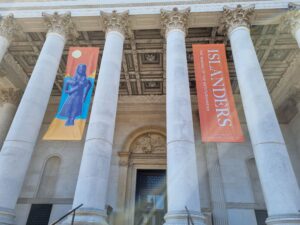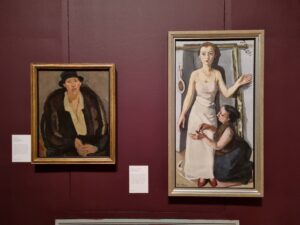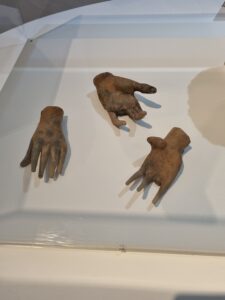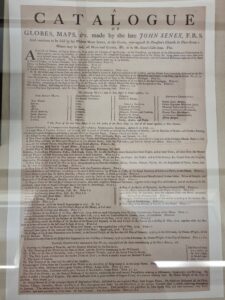On Thursday 20th April 2023, a group of GOTH members travelled to Cambridge for the annual GOTH awayday. This year, GOTH decided to visit a series of exhibitions at the Fitzwilliam Museum and the Whipple Museum.

Outside the Fitzwilliam Museum.
We began the day at the Fitzwilliam Museum to view the ‘Women: Makers and Muses’ temporary display, where curator Rebecca Birrell talked us through the artworks exhibited. One side of the room shows works by women artists, while the other shows representations of women by contemporary male artists to give a sense of the milieu in which the women artists were working. A highlight of this room for GOTH was Vanessa Bell’s Portrait of Mrs M. (1919), a depiction of the doctor Marie Moralt who saved Bell’s baby daughter’s life. Dr Moralt is depicted as a commanding presence in rich furs, her large hands suggesting her ability as a physician. Our attention was also drawn by Marie Louise von Motesiczky’s At the Dressmaker’s (1930), a self-portrait of the artist in a white gown, which is being worked on by another woman. Once again, Rebecca noted the oversized hands of the dressmaker, drawing attention to her skilled profession. We were particularly struck by the framing of the portrait with an alcove, curtain rod and curtain behind the subject, almost reminiscent of a funeral portrait. Across the room, we were intrigued by La zarzarrosa (The Dog-Rose) by Glyn Warren Philpot (1910-11), a group portrait of three Spanish dancers composed similarly to a traditional family portrait of the time. We discussed the ambiguous gender presentations of the three figures, ostensibly a man and two women, whose lavish clothing, playful expressions, and easy physicality were reminiscent of a sense of queer ‘found family’.

Paintings by Vanessa Bell and Louise von Motesiczky.
After lunch in the Courtyard Café, we moved onto the major exhibition ‘Islanders: The Making of the Mediterranean’. This exhibition draws together archaeological finds dating from the Bronze Age to the Roman period from Crete, Cyprus, and Sardinia to explore life on the large islands of the Mediterranean. Connected to the ‘Being an Islander: Art and Identity of the Large Mediterranean Islands’ research project, the exhibition explores religion, society, trade and other elements of life on the islands, displaying a range of objects including several never before seen in the UK. GOTH member and archaeologist Maria Relaki talked us through many aspects of the exhibition, including pottery that may have been designed to imitate more valuable metal vessels, and clay representations of humans, animals, chariots, and shrines.

Votive hands in the ‘Islanders’ exhibition.
Our final visit for the day was to the Whipple Museum of the History of Science. After perusing the permanent collection, curator Joshua Nall talked us through the ‘Craftswomen’ exhibition, which aims to uncover the hidden role of women in the history of manufacturing scientific instruments. We learned that many instrument businesses were registered in a man’s name but were taken over by that man’s wife when he died, suggesting the women in question had a good knowledge of how the business was run. These women even sometimes took on apprentices, proving that their knowledge extended to the actual making of instruments. Although these women did not sign their work with their own names, researchers have been able to uncover the crucial role that they played in the trade.

A catalogue of maps produced by John Senex; the business was run by his wife Mary.
We all had a great day in Cambridge, and were grateful to the curators for their insights!
